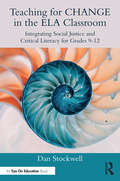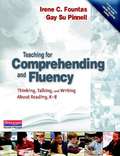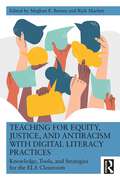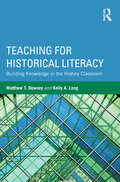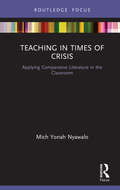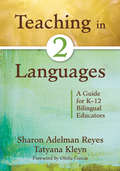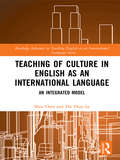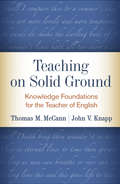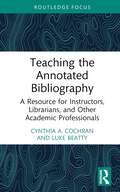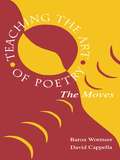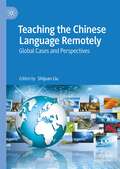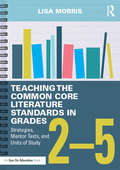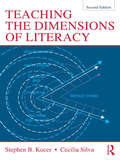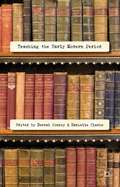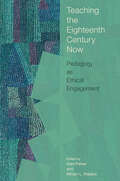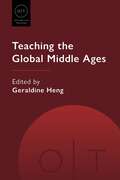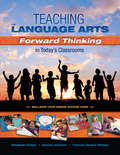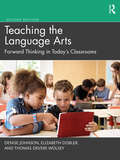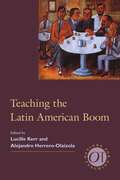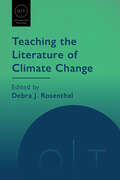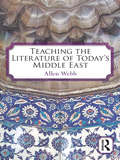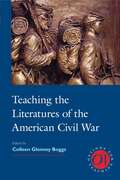- Table View
- List View
Teaching for CHANGE in the ELA Classroom: Integrating Social Justice and Critical Literacy for Grades 9-12
by Dan StockwellThis book can help you incorporate critical literacy pedagogy into your high school English Language Arts (ELA) classroom, so that your students can use what they study in class to work toward making a more just and equitable world.Through the acronym CHANGE, the book explores how critical literacy pedagogy can support students as they Challenge injustice to Help make a difference in the world by Asking and answering tough questions and Noticing ways to Get involved and Engaged in making the world a better place. It first centers on the theory behind critical literacy pedagogy with Bob Fecho’s concept of wobble, the tensions teachers experience when different points of view collide in the classroom, and why being mindful of and responding to moments of wobble can help educators grow in their teaching practice. The book then provides practical, specific suggestions by grade level for high school ELA teachers to implement critical literacy pedagogy in their classrooms, and address the tensions and moments of discomfort and uncertainty they might experience while providing critical literacy pedagogy.With detailed lesson plans and case study examples from in-service ELA teachers, this book is an incredible resource for high school language arts teachers who are interested in teaching for social justice and integrating critical literacy pedagogy into their classrooms.
Teaching for Comprehending and Fluency: Thinking, Talking, and Writing About Reading, K-8
by Gay Su Pinnell Irene C. FountasBook study groups and professional learning communities, click here to save 15% when you order 15 copies of Teaching for Comprehending and Fluency, K-8. Teaching for Comprehending and Fluency, K-8 is the next new breakthrough from Irene Fountas and Gay Su Pinnell. Offering a complete picture of how to skillfully teach meaning making and fluency within any instructional context, Teaching for Comprehending and Fluency, K-8, supports you with frameworks for high-quality instruction that describe appropriate expectations for comprehending, fluency, and vocabulary development. Fountas and Pinnell's teaching and assessment frames will give you a firm understanding of your students' reading levels: where they are, where they should be, and what they need to do to get there-for any reader, in any grade, at any moment. You'll also gain insight about the specific demands that fiction and nonfiction texts place on readers and about how effective readers think within a text, beyond a text, and about a text to gain rich understandings. As you learn about how the characteristics of texts help or hinder a reader's improvement, you'll find effective teaching strategies for: comprehending, word solving, fluency, and vocabulary writing about reading in a variety of genres and using writing as a tool for thinking using guided reading with fiction and nonfiction books discussing books during interactive read-aloud and literature study taking part in shared and performance reading. Fountas and Pinnell's teaching tips, smart strategies, proven classroom ideas, and professional-learning opportunities will lead the way as you discover how to help readers develop effective systems of strategic actions over time. You'll also learn how to take running records of reading behavior to assess comprehension and fluency then use those assessments to inform and differentiate your teaching. In addition, Fountas and Pinnell have also added a dynamic companion resource to Teaching for Comprehending and Fluency, K-8: a DVD containing short, focused video segments that illustrate concepts from the book and demonstrate exemplar teaching in real classroom settings. The DVD is also a repository of useful materials to support your work-including blackline masters, forms, checklists, and numerous other classroom tools. Fountas and Pinnell have developed detailed teaching guides for Teaching for Comprehending and Fluency. Perfect for staff development leaders or teacher educators, these guides offer all the specifics on leading a professional development program or preservice course on comphrension instruction with Teaching for Comprehending and Fluency as the core text. Each of the guides is written to address a specific course of study and is available for free download along with its accompanying course syllabus: Professional Development Program: Individual Study/Group Study (20 sessions) Preservice Teachers: One Semester Course (14-week college/university course) Preservice Teachers: One Quarter Course (11-week college/university course) Graduate Students: One Semester Course (14-week college/university course) Graduate Students: One Quarter Course (11-week college/university course) Click on the "Companion Resources" tab to download each of the guides. Discover powerful ways to help your students read with deep understanding and fluency. Read Teaching for Comprehending and Fluency, K-8 and be part of the big breakthrough in literacy instruction.
Teaching for Equity, Justice, and Antiracism with Digital Literacy Practices: Knowledge, Tools, and Strategies for the ELA Classroom
by Meghan E. Barnes Rick MarlattTo embrace today’s culturally and linguistically diverse secondary English Language Arts (ELA) classrooms, this text presents ways in which teachers can use digital tools in the service of antiracist teaching and developing equity-oriented mindsets in teaching and learning.Addressing how the use of digital tools and literacy practices can be woven into current ELA curricula, and with consistent sections, each chapter covers a different aspect of digital tool use, including multimodal texts, critical media literacies, connection-building, and digital composing. Understanding that no classroom is a monolith, Barnes and Marlatt’s timely text presents practical applications and resources suitable for different environments, including urban and rural contexts.The volume is essential reading in courses on ELA/literacy methods and multicultural education.
Teaching for Historical Literacy: Building Knowledge in the History Classroom
by Matthew T. Downey Kelly A. LongTeaching for Historical Literacy combines the elements of historical literacy into a coherent instructional framework for teachers. It identifies the role of historical literacy, analyzes its importance in the evolving educational landscape, and details the action steps necessary for teachers to implement its principles throughout a unit. These steps are drawn from the reflections of real teachers, grounded in educational research, and consistent with the Common Core State Standards. The instructional arc formed by authors Matthew T. Downey and Kelly A. Long takes teachers from start to finish, from managing the prior learning of students to developing their metacognition and creating synthesis at the end of a unit of study. It includes introducing topics by creating a conceptual overview, helping students collect and analyze evidence, and engaging students in multiple kinds of learning, including factual, procedural, conceptual, and metacognitive. This book is a must-have resource for teachers and students of teaching interested in improving their instructional skills, building historical literacy, and being at the forefront of the evolving field of history education.
Teaching in Times of Crisis: Applying Comparative Literature in the Classroom (Routledge Studies in Comparative Literature)
by Mich Yonah NyawaloTeaching in Times of Crisis explores how comparative methods, which are instrumental in reading and teaching works of literature from around the world, also provide us with tools to dissect and engage the moments of crises that permeate our contemporary political realities. The book is written in the form of a series of classroom reflections—or memos—capturing the political environment preceding and proceeding the 2016 US presidential election. It examines the ways in which the ethics involved in reading comparatively can be employed by teachers and students alike to map and foster "lifelines for cultural sustainability" (to borrow the term from Djelal Kadir’s Memos from the Besieged City) that are essential for creating and maintaining a healthy multicultural society. Nyawalo achieves this through comparative readings of postcolonial films, LGBTQ texts, French slam poetry, as well as episodes from Star Trek: The Next Generation, among other materials. The classroom reflections captured in each memo are shaped by the Appalachian setting in which the discussions and lessons took place. Inspired by this setting, the author develops pedagogic ethics of comparison—a method of reading comparatively—which privileges the local educational spaces in which students find themselves by mapping the contested cultural politics of Appalachian realities onto a world literature curriculum.
Teaching in Two Languages: A Guide for K–12 Bilingual Educators
by Sharon Adelman Reyes Tatyana KleynGrounded in the latest research, this book provides classroom-ready strategies for balancing instruction in two languages and meeting the unique challenges of educating English language learners.
Teaching of Culture in English as an International Language: An Integrated Model (Routledge Advances in Teaching English as an International Language Series #1)
by Shen Chen Thi Thuy LeThe importance of integrating the teaching and learning of language and culture has been widely recognised and emphasized. However, how to teach English as an International Language (EIL) and cultures in an integrative way in non-native English speaking countries remains problematic and has largely failed to enable language learners to meet local and global communication demands. Developing students’ intercultural competence is one of the key missions of teaching cultures. This book examines a range of well-established models and paradigms from both English-speaking and non-English speaking countries. Exploring questions of why, what, and how to best teach cultures, the authors propose an integrated model to suit non-native English contexts in the Asia Pacific. The chapters deal with other critical issues such as the relationship between language and power, the importance of power relations in communication, the relationship between teaching cultures and national interests, and balancing tradition and change in the era of globalisation. The book will be valuable to academics and students of foreign language education, particularly those teaching English as an international language in non-native English countries.
Teaching on Solid Ground: Knowledge Foundations for the Teacher of English
by Thomas M. McCann John V. Knapp Carol D. LeeTo be successful, teachers of English in grades 6–12 need more than basic content knowledge and classroom management skills. They need a deep understanding of the goals and principles of teaching literature, writing, oral discourse, and language in order to make sound instructional decisions. This engaging book explores the pedagogical foundations of the discipline and gives novice and future teachers specific guidance for creating effective, interesting learning experiences. The authors consider such questions as what makes a literary text worth studying, what students gain from literary analysis, how to make writing meaningful, and how to weave listening and speaking into every class meeting. Professional learning and course use are facilitated by end-of-chapter reflection questions, text boxes, and appendices showcasing exemplary learning activities.
Teaching the Annotated Bibliography: A Resource for Instructors, Librarians, and Other Academic Professionals
by Luke Beatty Cynthia A. CochranThis book informs instructors and librarians about the history, aims, and pedagogical uses of the annotated bibliography. A companion to the authors' Writing the Annotated Bibliography, this text enables instructors to better understand the annotated bibliography not only as a tool for research and composition but also as a valuable pedagogical tool. It provides practical guidance along with assignments, lesson plans, assessment rubrics, and other tools for using annotated bibliographies in effective and nuanced ways. It also contains annotated bibliography samples in APA, MLA, and Chicago styles. This practical book is of great use to instructors of composition and research skills, librarians, curriculum designers, writing center directors, and education professionals.
Teaching the Annotated Bibliography: A Resource for Instructors, Librarians, and Other Academic Professionals
by Luke Beatty Cynthia A. CochranThis book informs instructors and librarians about the history, aims, and pedagogical uses of the annotated bibliography. A companion to the authors' Writing the Annotated Bibliography, this text enables instructors to better understand the annotated bibliography not only as a tool for research and composition but also as a valuable pedagogical tool. It provides practical guidance along with assignments, lesson plans, assessment rubrics, and other tools for using annotated bibliographies in effective and nuanced ways. It also contains annotated bibliography samples in APA, MLA, and Chicago styles. This practical book is of great use to instructors of composition and research skills, librarians, curriculum designers, writing center directors, and education professionals.
Teaching the Art of Poetry: The Moves
by Baron Wormser A. David CappellaConcise and accessible, this guide to teaching the art of poetry from Shakespeare to contemporary poets enables anyone to learn about how poets approach their art. Teachers can use this book to explore any facet or era of poetry. Any reader can use it as an entryway into the art of poetry. Teaching the Art of Poetry shows poetry as a multi-faceted artistic process rather than a mystery on a pedestal. It demystifies the art of poetry by providing specific historical, social, and aesthetic contexts for each element of the art. It is a nuts-and-bolts approach that encourages teachers and students to work with poetry as a studio art--something to be explored, challenged, assembled and reassembled, imagined, and studied--all the things that an artist does to present poetry as a search for meaning. This book advocates poetry as an essential tool for aesthetic, cultural, and linguistic literacy. It portrays poetry as an art rather than a knowledge base, and methods for integrating the art of poetry into the school curriculum. The authors' intention is not to fill gaps; it is to change how poetry is presented in the classroom, to change how it is taught and how students think about it. Teaching the Art of Poetry: * Emphasizes hands-on experiences. Over 160 exercises focus attention on the dynamics of the art of poetry. Activities include group work, peer editing, critical thinking skills, revising drafts, focused reading, oral communication, listening skills, and vocabulary, as well as mechanics and usage. * Features a week-long lesson plan in each chapter to aid the teacher. These relate the main aspects of each chapter to classroom activities and, in addition, include a "Beyond the Week" section to promote further investigation of the topic. * Promotes an integrated approach to poetry. The examples used in each chapter show poetry as a living tradition. * Makes extensive use of complete poems along with extracts from many others. * Does not talk down to teachers--is teacher oriented and jargon free.
Teaching the Chinese Language Remotely: Global Cases and Perspectives
by Shijuan LiuThis edited book brings together global perspectives and case studies from five continents to provide an international picture of teaching Chinese remotely. It consists of 15 original chapters by 21 authors from 10 countries. Addressing both practice and research, these chapters collectively offer a comprehensive view of how Chinese language courses worldwide were urgently moved to fully online during the early stages of the Covid-19 pandemic.This edited volume reports fresh and first-hand experiences of Chinese language instructors and students in different countries as well as their perceptions of issues regarding remote teaching and learning in an emergency situation.The book will be of interest to Chinese language teachers and students, as well as scholars with a focus on language education and online teaching and learning more broadly.
Teaching the Common Core Literature Standards in Grades 2-5: Strategies, Mentor Texts, and Units of Study
by Lisa MorrisShifting your literature instruction to meet the Common Core can be tricky. The standards are specific about how students should analyze characters, themes, point of view, and more. In this new book, Lisa Morris makes it easy by taking you through the standards and offering tons of practical strategies, tools, and mentor texts for grades 2-5. She shows you how to combine the standards into effective units of study so that you can teach with depth rather than worry about coverage. Topics covered include: Teaching questioning, inferring, and author’s purpose; Guiding readers to look at themes and write summaries; Showing students how to recognize structural elements of literature; Teaching the craft of writing and vocabulary development; and Helping students analyse characters and character development. Throughout this highly practical book, you’ll find a variety of charts and other graphic organizers that can be easily adapted for classroom use. A list of suggested mentor texts is also available as a free eResource from our website, www.routledge.com/books/details/9781138856172.
Teaching the Dimensions of Literacy: A Conceptual Base For The Teaching Of Reading And Writing In School Settings
by Stephen Kucer Cecilia SilvaTeaching the Dimensions of Literacy provides both the conceptual knowledge to support teachers' instructional decisions in the reading/literacy classroom and a multitude of instructional strategy lessons for classroom use with both monolingual and bilingual students. It proposes that teachers need to help children become code breakers (the linguistic dimension), meaning makers (the cognitive dimension), text users and critics (the sociocultural dimension), and scientists (the developmental dimension). Acknowledging and addressing all four dimensions, this text links literacy theory, literacy research, and literacy practice in a useable way. Covering both reading and writing, it features clear, concise, and useable reading and writing strategy lessons and ways to modify them for different types of students. Changes in the Second Edition: Entirely reorganized, the text is more user friendly, builds a stronger link between theory and practice, and makes it is easier for teachers to locate appropriate strategy lessons to use with their students. Academic literacy is addressed more fully.
Teaching the Early Modern Period
by Derval Conroy Danielle ClarkeThis innovative project unites leading scholars of English, History and French to examine the challenges of teaching early modern literature, history and culture within higher education. The volume sets out a variety of approaches to teaching the period and aims to revitalize the connection between teaching and research.
Teaching the Eighteenth Century Now: Pedagogy as Ethical Engagement (Transits: Literature, Thought & Culture, 1650-1850)
by Kate Parker Tiffany Potter Diana Epelbaum Teri Doerksen Ziona Kocher Christine D. Myers Matthew L. Reznicek Travis Chi Lau Emily C. Casey Eugenia ZuroskiIn this timely collection, teacher-scholars of “the long eighteenth century,” a Eurocentric time frame from about 1680 to 1832, consider what teaching means in this historical moment: one of attacks on education, a global contagion, and a reckoning with centuries of trauma experienced by Black, Indigenous, and immigrant peoples. Taking up this challenge, each essay highlights the intellectual labor of the classroom, linking textual and cultural materials that fascinate us as researchers with pedagogical approaches that engage contemporary students. Some essays offer practical models for teaching through editing, sensory experience, dialogue, or collaborative projects. Others reframe familiar texts and topics through contemporary approaches, such as the health humanities, disability studies, and decolonial teaching. Throughout, authors reflect on what it is that we do when we teach—how our pedagogies can be more meaningful, more impactful, and more relevant. Published by Bucknell University Press. Distributed worldwide by Rutgers University Press.
Teaching the Global Middle Ages (Options for Teaching #54)
by Geraldine HengWhile globalization is a modern phenomenon, premodern people were also interconnected in early forms of globalism, sharing merchandise, technology, languages, and stories over long distances. Looking across civilizations, this volume takes a broad view of the Middle Ages in order to foster new habits of thinking and develop a multilayered, critical sense of the past.The essays in this volume reach across disciplinary lines to bring insights from music, theater, religion, ecology, museums, and the history of disease into the literature classroom. The contributors provide guidance on texts such as the Thousand and One Nights, Sunjata, Benjamin of Tudela's Book of Travels, and the Malay Annals and on topics such as hotels, maps, and camels. They propose syllabus recommendations, present numerous digital resources, and offer engaging class activities and discussion questions. Ultimately, they provide tools that will help students evaluate popular representations of the Middle Ages and engage with the dynamics of past, present, and future world relationships.
Teaching the History of the English Language (Options for Teaching #46)
by Colette Moore and Chris C. PalmerThe study of the history of the English language (HEL) encompasses a broad sweep of time and space, reaching back to the fifth century and around the globe. Further, the language has always varied from place to place and continues to evolve today. Instructors face the challenges of teaching this vast subject in one semester and of engaging students with unfamiliar material and techniques. This volume guides instructors in designing an HEL course suited to their own interests and institutions.The essays consider what subjects of HEL to include, how to organize the course, and what textbook to assign. They offer historical approaches and those that are not structured by chronology. Sample assignments provide opportunities for students to conduct original research, work with archives and digital resources, and investigate language in their communities. The essays also help students question notions of linguistic correctness.
Teaching the Italian Renaissance Romance Epic (Options for Teaching #44)
by Jo Ann CavalloThe Italian romance epic of the fifteenth and sixteenth centuries, with its multitude of characters, complex plots, and roots in medieval Carolingian epic and Arthurian chivalric romance, was a form popular with courtly and urban audiences. In the hands of writers such as Boiardo, Ariosto, and Tasso, works of remarkable sophistication that combined high seriousness and low comedy were created. Their works went on to influence Cervantes, Milton, Ronsard, Shakespeare, and Spenser.In this volume instructors will find ideas for teaching the Italian Renaissance romance epic along with its adaptations in film, theater, visual art, and music. An extensive resources section locates primary texts online and lists critical studies, anthologies, and reference works.
Teaching the Language Arts: Forward Thinking in Today's Classrooms
by Elizabeth Dobler Thomas DeVere Wolsey Denise JohnsonTeaching the Language Arts helps readers envision their future classrooms, including the role technology will play, as they prepare to be effective teachers. The book’s multimedia digital format represents a distinctive way to learn about teaching—combining traditional and electronic content, resources, and pedagogy to create a powerful, interactive experience that encourages active learning. Readers can explore a rich array of teaching tools and experiences, including an effective blend of classroom photographs (taken by the authors during school visits), student samples, podcast interviews with teachers and students, classroom videos, and online resources—all of which allow readers to learn from real-world classrooms. This book’s unique and engaging voice, supported by its multimedia approach, will help future and in-service teachers bring the language arts to life in their own classrooms. Visit the Companion Website at www.routledge.com/cw/dobler for information on accessing the interactive e-book and additional ideas and resources to help you and your students use it to its full potential.
Teaching the Language Arts: Forward Thinking in Today's Classrooms
by Elizabeth Dobler Thomas DeVere Wolsey Denise JohnsonThis book helps readers envision their future classrooms, including the role technology will play, as they prepare to be successful teachers. Comprehensively updated, the second edition addresses new demands on teaching in traditional and virtual ELA classrooms, and the new ways technology facilitates effective instructional practices. Organized around the receptive language arts—the way learners receive information—and the expressive language arts—the way leaners express ideas—chapters cover all aspects of language arts instruction, including new information on planning and assessment; teaching reading and writing fundamentals; supporting ELLs, dyslexic, and dysgraphic learners; using digital tools; and more. In every chapter, readers can explore a rich array of teaching tools and experiences, which allow readers to learn from real-world classrooms. The eBook+ version includes interactive features and links to the up-to-date Companion Website, with more strategies, and examples of practice and student work. This book’s unique and engaging voice, supported by its many resources, will help future and in-service teachers bring the language arts to life in their own classrooms.
Teaching the Latin American Boom (Options for Teaching #37)
by Lucille Kerr and Alejandro Herrero-OlaizolaIn the decade from the early 1960s to the early 1970s, Latin American authors found themselves writing for a new audience in both Latin America and Spain and in an ideologically charged climate as the Cold War found another focus in the Cuban Revolution. The writers who emerged in this energized cultural moment--among others, Julio Cortázar (Argentina), Guillermo Cabrera Infante (Cuba), José Donoso (Chile), Carlos Fuentes (Mexico), Gabriel García Márquez (Colombia), Manuel Puig (Argentina), and Mario Varas Llosa (Peru)--experimented with narrative forms that sometimes bore a vexed relation to the changing political situations of Latin America.This volume provides a wide range of options for teaching the complexities of the Boom, explores the influence of Boom works and authors, presents different frameworks for thinking about the Boom, proposes ways to approach it in the classroom, and provides resources for selecting materials for courses.
Teaching the Literature of Climate Change (Options for Teaching)
by Debra J. RosenthalOver the past several decades, writers such as Margaret Atwood, Paolo Bacigalupi, Octavia E. Butler, and Kathy Jetn̄il-Kijiner have explored climate change through literature, reflecting current anxieties about humans' impact on the planet. Emphasizing the importance of interdisciplinarity, this volume embraces literature as a means to cultivate students' understanding of the ongoing climate crisis, ethics in times of disaster, and the intrinsic intersectionality of environmental issues.Contributors discuss speculative climate futures, the Anthropocene, postcolonialism, climate anxiety, and the usefulness of storytelling in engaging with catastrophe. The essays offer approaches to teaching interdisciplinary and cross-listed courses, including strategies for team-teaching across disciplines and for building connections between humanities majors and STEM majors. The volume concludes with essays that explore ways to address grief and to contemplate a hopeful future in the face of apocalyptic predictions.
Teaching the Literature of Today's Middle East
by Allen WebbProviding a gateway into the real literature emerging from the Middle East, this book shows teachers how to make the topic authentic, powerful, and relevant. Teaching the Literature of Today’s Middle East:• Introduces teachers to this literature and how to teach it• Brings to the reader a tremendous diversity of teachable texts and materials by Middle Eastern writers • Takes a thematic approach that allows students to understand and engage with the region and address key issues • Includes stories from the author’s own classroom, and shares student insight and reactions• Utilizes contemporary teaching methods, including cultural studies, literary circles, blogs, YouTube, class speakers, and film analysis• Directly and powerfully models how to address controversial issues in the region Written in an open, personal, and engaging style, theoretically informed and academically smart, highly relevant across the field of literacy education, this text offers teachers and teacher-educators a much needed resource for helping students to think deeply and critically about the politics and culture of the Middle East through literary engagements.
Teaching the Literatures of the American Civil War (Options for Teaching #39)
by Colleen Glenney BoggsWhen Abraham Lincoln met Harriet Beecher Stowe in 1863, he reportedly greeted her as "the little woman who wrote the book that started this Great War." To this day, Uncle Tom's Cabin serves as a touchstone for the war. Yet few works have been selected to represent the Civil War's literature, even though historians have filled libraries with books on the war itself.This volume helps teachers address the following questions: What is the relation of canonical works to the multitude of occasional texts that were penned in response to the Civil War, and how can students understand them together? Should an approach to war literature reflect the chronology of historical events or focus instead on thematic clusters, generic forms, and theoretical concerns? How do we introduce students to archival materials that sometimes support, at other times resist, the close reading practices in which they have been trained?Twenty-three essays cover such topics as visiting historical sites to teach the literature, using digital materials, teaching with anthologies; soldiers' dime novels, Confederate women's diaries, songs, speeches; the conflicted theme of treason, and the double-edged theme of brotherhood; how battlefield photographs synthesize fact and fiction; and the roles in the war played by women, by slaves, and by African American troops. A section of the volume provides a wealth of resources for teachers.
